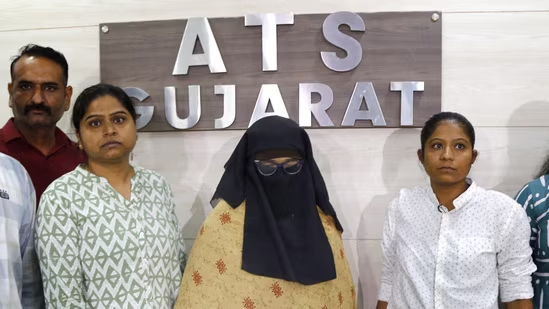
Bengaluru
Shama Parveen Ansari, a 30-year‑old originally from Jharkhand and residing in Bengaluru for around three to five years, was arrested by the Gujarat Anti‑Terrorism Squad (ATS) on July 29, 2025. She is accused of operating an Al‑Qaeda in the Indian Subcontinent (AQIS) propaganda and radicalisation network, leveraging social media to spread extremist content and recruit youth to its ideology.
Background & Arrest Details
Shama—also referred to as Sama Parveen in some reports—was detained at her rented flat in Bengaluru’s Manorayanapalya (Hebbal) by Gujarat ATS acting on intelligence obtained from earlier arrests in Abu Dhabi, Ahmedabad, Delhi, Noida, and Modasa
Officials confirmed she lived with her brother, a software engineer, and had been active on social platforms, particularly Instagram and Facebook, for at least three years using two Facebook accounts and one Instagram account with roughly 10,000 followers.
Alleged Role in AQIS Network
Authorities allege Ansari was a key conspirator coordinating a terror module from Bengaluru that spread extremist ideas, notably promoting “Ghazwa‑e‑Hind”—a radical narrative enjoining armed conflict in India. She reportedly reposted speeches of AQIS leaders, including Asim Umar and radical cleric Abdul Aziz of Islamabad, encouraging jihad and violence.
Her devices revealed regular communication with four other suspects—Mohammad Faiq (Delhi), Fardeen Sheikh (Ahmedabad), Zeeshan Ali (Noida), and Sefullah Qureshi (Modasa)—all arrested in the same network. These individuals had been running linked social media accounts that identified and radicalised youth across regions.
Forensic analysis indicates she collaborated with Pakistan‑based operatives, exchanging propaganda via Instagram handles such as “strangers_nation02” and interacting with accounts tied to AQIS literature.
Modus Operandi: Social Media as a Tool of Radicalisation
Investigators traced Ansari’s online presence to key Instagram accounts like @sharyat_ya_shahadat, @f4rdeen_03, @_mujahideen1, and @sefullah_muja_hid313, which she either managed or interacted with actively. These accounts were central to projecting AQIS ideology, glorifying militant speech, and inciting violence against democratic institutions
According to Gujarat ATS, she downloaded extremist videos from these platforms, reedited content, and reposted speeches endorsing religious conflict—aiming to radicalise disaffected youth. Officials described her social media behaviour as “highly radicalised.”
Broader Implications & Security Measures
Ansari’s arrest is part of an ongoing nationwide crackdown by Gujarat ATS against AQIS-linked operatives, marking at least five arrests in the past week. Authorities stress the significance of sleeper-cell networks and online radical enablers in urban centres like Bengaluru.
Security agencies are now expanding surveillance across social media platforms, identifying related profiles, tracking suspicious groups, and strengthening collaboration between Gujarat ATS, Bengaluru police, and national agencies. A transit warrant has been obtained to shift her custody to Gujarat, while Bengaluru Police maintain heightened vigilance across the city.
Experts warn that the case underscores how extremist groups are increasingly exploiting women and social media as vectors for radicalisation—posing new challenges for law enforcement
Summary at a Glance
| Topic | Details |
|---|---|
| Name | Shama Parveen Ansari (also Sama Parveen) |
| Age & Origin | 30, Jharkhand |
| Location | Bengaluru, Karnataka (resided 3–5 years) |
| Arresting Agency | Gujarat ATS (with Bengaluru Police) |
| Accusations | Leading AQIS propaganda & radicalisation module |
| Medium Used | Instagram, Facebook (2 FB, 1 IG account) |
| Followers Count | ~10,000 on Instagram |
| Network Links | Communicated with four other accused in Delhi, Gujarat, Noida |
| Ideology Promoted | Ghazwa-e-Hind, speeches of AQIS leaders |
| Legal Process | Transit warrant granted; produced before court in Ahmedabad |
Conclusion
The arrest of Shama Parveen Ansari marks a decisive intervention against AQIS’s evolving tactics—particularly using women as online radicals and recruiters. Her alleged role in coordinating cross-state radicalisation activities through social media speaks to the complex, decentralized nature of modern extremist networks.
This case serves as a reminder of the urgent need for proactive monitoring of social media spaces used for ideological propagation, strengthening forensic digital intelligence, and enhancing coordination between state and national security agencies.
As law enforcement proceeds with further probes into her digital and social network, authorities stress that India remains committed to neutralising all forms of terror-related facilitation—whether physical or virtual.
Thanks For Reading